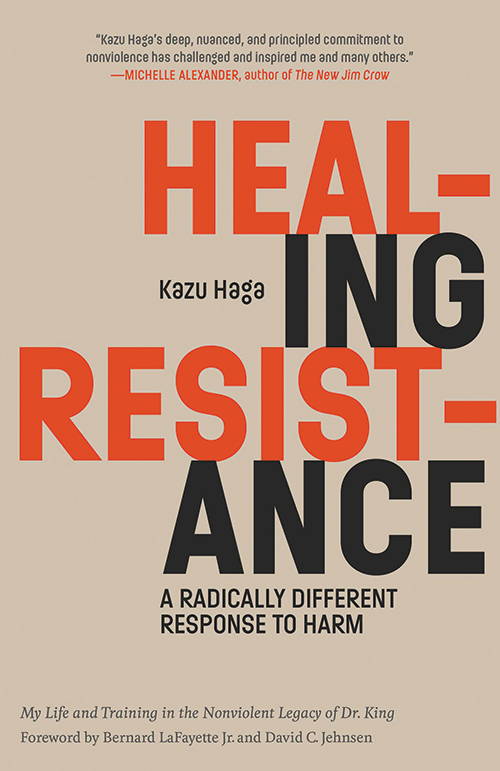
Healing Resistance: A Radically Different Response to Harm
Reviewed by Patience A. Schenck
January 1, 2022
By Kazu Haga. Parallax Press, 2020. 296 pages. $17.95/paperback; $12.99/eBook.
In our society, violence—physical or mental—is often considered the appropriate response to conflict. Someone breaks a law? Get them arrested. Someone insults you? Get even. Foreigners create an offense against your country? Bomb someone. We think these responses will make us feel strong. We think they will make us safe.
It seems clear that people will not stop believing that arrest and incarceration, insulting someone, fighting, waging wars, and other violent responses to conflict are required for our safety until they are shown alternative ways of being safe. While there is enough of a body of knowledge and experience to allow one to get an advanced degree in peace studies, many people (including our governmental leaders) lack a good understanding of peaceful responses to violence.
Kazu Haga comes to the rescue! This readable and heartfelt presentation on the nonviolent legacy of Martin Luther King Jr. will leave the contemporary reader with a good foundation in nonviolence.
Haga’s approach is autobiographical: describing the books, events, and training that he found life changing. He writes with heart and humor, and because his approach is so conversational, it was a while before I realized how wise and grounded he is not only in theory but also in personal experience.
Born in Japan, Haga came to the United States at the age of seven. As a rebellious teenager, he dropped out of high school and went searching for a community. He said it could have been a gang, a cult, or the military. However, fortunately for all of us, he decided to join a pilgrimage to retrace the transatlantic slave trade with a group deeply committed to nonviolence and social change. Soon, he saw the possibilities of nonviolence, and he was hooked.
A guiding principle of nonviolence, whether theoretical or practical, is that the goal is always to support the Beloved Community. Throughout Haga balances strategy and activism with personal healing and transformation—of ourselves and of those with whom we are in conflict—a necessary condition for healing relationships. The well-being of everyone in a conflict is important; building and protecting relationships is paramount.
Nonviolence is taking a stand against violence and injustice. It is action not passivity, which is a common misperception. It requires proactivity and strategy to address the root causes of conflict. It means noticing warning signs before someone gets hurt. It means learning the history of a conflict; for example, one cannot understand the uprisings against the killing of Black people by police without knowing the legacy of slavery, Jim Crow, and mass incarceration.
In dealing with a conflict, the nonviolence practitioner must explore others’ viewpoints to understand where they are coming from. One must avoid a right/wrong binary, and look for truth on all sides. He reminds us that listening to an opinion is not condoning it. The empathy that allows us to understand someone’s perspective is not just about being nice. It is strategic and smart.
Over the years, Haga learned many skills, such as creating proper structures. An example is using a talking stick to facilitate an orderly discussion and careful listening to one another.
Giving several pages to each, he explores six principles of nonviolence:
- Nonviolence is a way of life for courageous people.
- The Beloved Community is the framework for the future.
- Attack forces of evil, not persons doing evil.
- Accept suffering without retaliation for the sake of the cause to achieve the goal.
- Avoid internal violence of the spirit as well as external physical violence.
- The universe is on the side of justice.
The author shares with us his own inner journey as he prepared himself for the sacrifice and willingness to suffer required for nonviolent action. We also see the joy he has found in this work.
My one critique is that this book does not explore the possibilities of nonviolence in an international setting. History shows many successful nonviolent responses to violence, yet our children learn history with a focus on wars.
I cannot recommend this book enough, whether for the novice to nonviolence or for someone needing a refresher and some inspiration.
Patience A. Schenck is a member of Annapolis (Md.) Meeting and a resident of Friends House in Sandy Spring, Md., where she clerks the Diversity Committee. Learning and then passing along what she has learned is her greatest joy.


